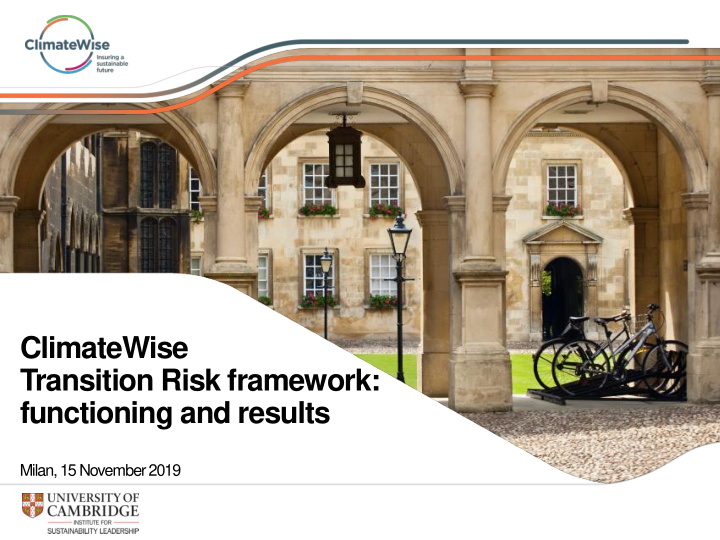



ClimateWise Transition Risk framework: functioning and results Milan, 15 November 2019
2 University of Cambridge Institute for Sustainability Leadership (CISL) Centre for Sustainable Finance Working with over 50 global financial institutions across banking, insurance ➢ ClimateWise and investment, we provide the insight ➢ Banking Environment Initiative needed to challenge current ➢ Investment Leaders Group assumptions and lead change
3 ClimateWise network and engagement ClimateWise is a global network of leading insurers, reinsurers, brokers and industry service providers who share a commitment to reducing the impact of climate change on society, as well as the insurance industry. The ClimateWise Transition Risk framework has been tried-and- tested , applying it to three real-life portfolios of: ▪ two of the world’s largest insurance companies ▪ one of the global top five investors in infrastructure
4 ClimateWise Transition Risk framework supports the TCFD approach TCFD scenario analysis approach & CW Transition Risk framework ClimateWise Transition Risk framework
5 The framework aims to enhance understanding of low carbon transition impacts on infrastructure investments
6 5 key components of the framework A. Infrastructure assets in scope B. Geographies C. Scenarios D. Timeframes ▪ Europe ▪ Business-as- ▪ 2020 Usual: 3.7C ▪ US ▪ 2030 ▪ Paris Agreem. ▪ India ▪ 2040 (NDCs): 2.7C ▪ 2C scenario ➢ E. Financial drivers Tried-and-tested (3 real-life portfolios) + feedback from regulatory bodies and industry stakeholders ➢ Assumptions/data sources in clear text (no black box) ➢ Open-source with possibility to customise
Step 1 - Portfolio Risk & Opportunity Exposure
8 Step 1(a): assess infrastructure asset types most exposed to the low carbon transition Infrastructure Risk* Exposure Matrix (extract) In the Power Generation sector (Paris Agreement-NDCs scenario): ▪ EU is exposed to a medium risk for Coal-fired power plants (25-50% variation of financial drivers vs business as usual scenario) ▪ There is minimal risk associated with gas-fired power generation (<10% variation of financial drivers vs business as usual scenario) Note: (*) Considered Transition risks, as defined by the G20 Financial Stability Board’s TCFD: Market and Technology Shifts, Reputation, Policy and Legal
9 Step 1(b): assess portfolios exposure Infrastructure Risk* Portfolio Risk* & Opportunities Exposure Matrix exposure (real-life portfolios) Note: (*) Considered Transition risks, as defined by the G20 Financial Stability Board’s TCFD: Market and Technology Shifts, Reputation, Policy and Legal
10 Step 1 (c): identify exposed assets in the portfolio to inform for future investment strategy Information for CIOs to support guidelines on investment strategy Identify the assets in the portfolio that are highlighted as having high financial risk or opportunity accounting for transition risk and material value in the portfolio . The results can be used to: a) inform future portfolio investment strategy – including allocation of funds or divestments b) select assets for more granular assessment in Steps 2 and 3 of the framework
Step 2 - Asset Impact Identification & Step 3 - Financial Modelling Analysis
12 Step 2: assess the financial impact from the low carbon transition at an asset-by-asset level Asset Impact Identification Methodology Risks vary considerably between assets of the same type (geography, carbon intensity, market positioning…) Investors can gain benefits in conducting an asset-level specific analysis applying/ customising the Infrastructure Risk Exposure Matrix per each specific asset
13 Step 3: allow investors to incorporate the potential impacts of transition risk directly into their own financial models Step 3(a) Interpolate financial Step 3(b): Assess financial drivers in the model materiality Asset managers can incorporate risks to Asset managers and owners financial drivers of revenue and costs into could then assess how the low carbon their own asset financial model , referring to transition could impact a variety of the the outputs from: asset’s financial metrics and leverage the ▪ Infrastructure Risk Exposure Matrix, work to consider exit strategies where risk is ▪ Asset Impact Identification Methodology high, or develop investment options to ▪ relevant scenario data sets improve asset resilience
14 Future evolution ➢ Annual update of existing framework (assumptions, data- sets…) for releasing in Q1 of each year ➢ Extension of the Transition Risk framework for: ▪ new Sectors → Real Estate ▪ new Geographies → China ▪ new Climate scenarios → 1.5C and 6C ▪ new Timeframes → 2025 (instead of 2020)
15 Contacts and further information Dr Bronwyn Claire Andrea Gangheri Senior Programme Manager, CISL – Centre Senior Associate, CISL – Centre for for Sustainable Finance | ClimateWise Sustainable Finance bronwyn.claire@cisl.cam.ac.uk andrea.gangheri@cisl.cam.ac.uk www.cisl.cam.ac.uk/business-action/sustainable-finance/climatewise
Recommend
More recommend